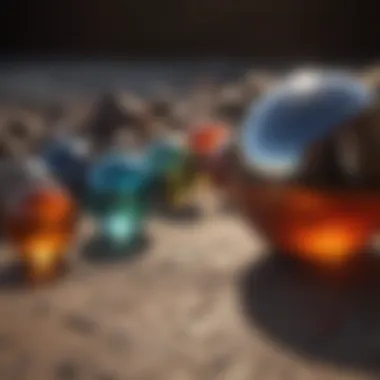Unveiling the Significance of Polishing Compound Colors in Rock and Fossil Collection


Rock and Fossil Identification
As a rock and fossil enthusiast delving into the captivating world of geological specimens, understanding the various colors of polishing compounds is paramount for refining your collection. Different hues signify distinct properties that can enhance the beauty and presentation of rocks and fossils, elevating your expertise in this intricate art form.
In the realm of rock and fossil identification, it is essential to grasp the types of rocks and fossils one might encounter. Whether it's igneous, sedimentary, or metamorphic rocks, each category holds unique characteristics waiting to be explored. Fossils, on the other hand, offer a window into ancient life, with various forms ranging from imprints to petrified remains. Knowing these distinctions empowers collectors to discern and appreciate each specimen's individuality.
When examining rocks and fossils, specific characteristics act as tell-tale signs for identification. Texture, color, and structure play key roles in determining the composition and origin of a specimen. Tools such as magnifying lenses and hardness testing kits aid in this process, allowing collectors to assess properties that can't be seen with the naked eye. By honing these skills, enthusiasts can develop a keen eye for detail and accuracy in their identification endeavors.
Introduction
The realm of rock and fossil collection holds hidden treasures waiting to be unearthed and polished to reveal their true beauty. In this article, we embark on a journey to unravel the mysteries surrounding the different colors of polishing compounds. As aficionados of geological specimens delve deeper into the art of polishing, understanding the significance of each tint becomes imperative. By grasping the subtle nuances behind the diverse hues of polishing compounds, collectors can elevate their craft and breathe life into their precious finds.
Peering into the rainbow of polishing compounds, we find a spectrum of colors each holding a unique key to unlocking enhanced techniques and results. The mysteries lie not just in the visual allure of these colors but in their intrinsic meanings that impact the final outcome of a polished masterpiece. Deciphering the language of colors in the polishing world is akin to learning a secret code that can transform ordinary rocks into dazzling gems.
Beyond the visual appeal, the significance of different colors in polishing compounds extends to practical benefits and considerations. Each hue represents a specific composition tailored to meet the demanding needs of various rocks and fossils. This intricate balancing act between color and composition is the essence of successful polishing techniques, where the right choice can spell the distinction between mediocrity and perfection. By shedding light on the importance of colors in polishing compounds, this article aims to equip enthusiasts with the knowledge needed to navigate the intricate world of rock and fossil collection with finesse and precision.
Understanding Polishing Compounds
In the realm of rock and fossil collection, the significance of different colors of polishing compounds cannot be overstated. These compounds play a vital role in enhancing the appearance and quality of geological specimens. Understanding the nuances of polishing compounds is essential for enthusiasts looking to elevate their polishing techniques and achieve superior results. By grasping the implications of each color variation in the compounds, collectors can further their expertise in handling and presenting geological treasures.
What Are Polishing Compounds?
Polishing compounds are abrasive substances used in the final stages of the polishing process to achieve a smooth and glossy finish on surfaces. Comprised of fine particles such as aluminum oxide or cerium oxide suspended in a medium, these compounds come in various colors to denote their specific properties and intended applications. Each color corresponds to a different composition and abrasive level, catering to unique polishing requirements and desired outcomes.
Purpose of Using Polishing Compounds


The primary purpose of utilizing polishing compounds is to refine surfaces post-grinding or sanding, imparting a lustrous sheen and optical clarity to materials. These compounds assist in removing imperfections, scratches, and dullness, thereby enhancing the visual appeal of rocks and fossils. Moreover, they play a crucial role in sealing porosities and enhancing the overall durability of the finished specimens. By utilizing the appropriate polishing compound, collectors can achieve a professional finish and reveal the intricate details of geological formations with precision and finesse.
Significance of Colors in Polishing Compounds
Polishing compounds play a crucial role in the world of rock and fossil collection, aiding enthusiasts in enhancing the appearance and quality of their geological specimens. The significance of colors in polishing compounds lies in their ability to indicate different formulations and abrasive levels, allowing collectors to choose the most suitable one for their specific needs. By understanding the meaning behind each color, collectors can optimize their polishing techniques and achieve the desired results with precision and efficiency. Furthermore, the colors serve as a guide for selecting the right compound for different materials, finishes, and equipment, emphasizing the importance of color coding in the polishing process.
Red Polishing Compound
When it comes to red polishing compounds, they are known for their high abrasive properties and are ideal for effectively removing scratches, imperfections, and achieving a glossy finish on various surfaces. The key characteristic of red compounds is their aggressive cutting action, making them a popular choice for initial polishing stages where heavy material removal is required. One unique feature of red compounds is their versatility in working on metals, plastics, and softer stones, providing users with excellent versatility and efficiency in polishing processes.
Green Polishing Compound
Green polishing compounds are favored for their versatility and effectiveness in achieving a high shine on metals and hard surfaces. The key characteristic of green compounds is their fine abrasive grit, which enables them to produce a bright and smooth finish without leaving visible scratches or marks. The unique feature of green compounds lies in their gentle yet powerful polishing action, making them suitable for delicate materials while still delivering exceptional results. Users appreciate green compounds for their ability to provide a mirror-like finish with minimal effort and a long-lasting shine.
White Polishing Compound
White polishing compounds are recognized for their gentle abrasive properties, making them suitable for final polishing stages to impart a brilliant and flawless finish. The key characteristic of white compounds is their ultra-fine abrasive particles, which help in removing minor imperfections, restoring luster, and enhancing the clarity of surfaces. The unique feature of white compounds is their ability to bring out the natural beauty of materials without causing damage, ensuring a pristine and polished appearance. Users admire white compounds for their ability to create a perfect finish with a smooth and reflective surface.
Black Polishing Compound
Black polishing compounds are valued for their ability to provide a powerful cutting action while leaving a refined and smooth finish on surfaces. The key characteristic of black compounds is their balanced abrasive grit, allowing for efficient material removal without excessive dulling or scratching. The unique feature of black compounds is their versatility in working on a wide range of materials, from metals to carbon steel, providing users with a reliable option for achieving precision and excellence in polishing tasks. Users favor black compounds for their ability to deliver consistent results and a professional-looking finish.
Blue Polishing Compound
Blue polishing compounds are known for their medium abrasive qualities, making them a popular choice for achieving a uniform and polished surface on metals and alloys. The key characteristic of blue compounds is their moderate cutting ability, which allows for effective material removal while maintaining surface integrity and smoothness. The unique feature of blue compounds is their ability to produce a clean and glossy finish without compromising the material's structure or detail. Users appreciate blue compounds for their balance of cutting power and surface refinement, providing an excellent solution for various polishing applications.


Yellow Polishing Compound
Yellow polishing compounds are distinguished by their light abrasive properties, designed to refine surfaces and enhance shine without causing damage or scratches. The key characteristic of yellow compounds is their gentle polishing action, making them suitable for final finishing touches and bringing out the best in materials. The unique feature of yellow compounds is their ability to provide a bright and polished look while ensuring the preservation of surface details and integrity. Users value yellow compounds for their ability to deliver a smooth and flawless finish with a radiant and long-lasting sheen.
Choosing the Right Polishing Compound for Your Needs
When it comes to the intricate world of rock and fossil collection, selecting the appropriate polishing compound is paramount. Choosing the right polishing compound for your needs can significantly impact the final outcome of your polishing efforts. It is crucial to consider various factors to ensure the best results possible. Proper selection not only enhances the appearance of your geological specimens but also improves the efficiency of the polishing process. Understanding the significance of selecting the right polishing compound is essential for rock and fossil collectors looking to elevate their craft to the next level.
Factors to Consider
Material Type:
The material type plays a pivotal role in determining the effectiveness of the polishing compound. Different materials require specific compounds to achieve optimal results. For instance, softer rocks may need a gentler compound to prevent damage, while harder surfaces might require a more abrasive polishing agent. By understanding the characteristics of each material type, collectors can choose the most suitable compound for their polishing needs. Selecting the correct material type ensures a precise and desired finish without compromising the integrity of the specimen.
Desired Finish:
Determining the desired finish is another critical factor in choosing the right polishing compound. Whether aiming for a smooth surface or a glossy shine, the desired finish guides the selection process. Each polishing compound offers unique properties that cater to different finishing requirements. By aligning the desired finish with the appropriate compound, collectors can achieve the desired aesthetic outcome effectively.
Polishing Equipment:
The type of polishing equipment used also influences the choice of polishing compound. Various tools, such as rotary polishers or vibratory tumblers, interact differently with different compounds. Understanding how the polishing equipment interacts with the compound helps collectors optimize their polishing techniques. Matching the right polishing equipment with the appropriate compound ensures efficient polishing and prevents damage to the geological specimens. By considering the characteristics of the polishing equipment, collectors can streamline their polishing process and achieve exceptional results.
Testing Different Compounds
Trial and Error Approach:


Experimenting with different compounds through a trial and error approach is a valuable method to determine the most suitable option for specific specimens. By testing various compounds on sample surfaces, collectors can observe how each product affects the material and adjust their selection accordingly. The trial and error approach allows collectors to refine their techniques and select the best compound for different materials, ensuring optimal polishing results.
Observing Effects:
Carefully observing the effects of each compound during the polishing process provides valuable insights into their performance. By closely monitoring how a compound interacts with the material, collectors can assess its effectiveness in achieving the desired finish. Observing the effects also helps in identifying any potential issues or limitations of the compound, enabling collectors to make informed decisions when selecting the most appropriate polishing agent. Through meticulous observation, collectors can refine their polishing techniques and enhance the overall quality of their polished specimens.
Tips for Effective Polishing Techniques
Being a savvy rock and fossil collector entails mastering the art of effective polishing techniques. Polishing is not just a mechanical process; it is an intricate craft that demands attention to detail and finesse. In this article, we delve into how the right polishing techniques can elevate your specimens to a whole new level of brilliance. By understanding the nuances of proper polishing, you can ensure that your prized specimens shine with resplendent beauty.
Proper Application Methods
Proper application methods are the backbone of successful polishing. It is essential to apply the polishing compound evenly and consistently across the surface of the specimen. By using the correct pressure and motion, you can achieve a smooth and uniform finish that highlights the natural beauty of the rock or fossil. Whether you are using a cloth wheel, a brush, or any other tool, mastering the proper application techniques will ensure optimal results.
Avoiding Common Mistakes
Overuse of Compound
The overuse of compound can have detrimental effects on the polishing process. Excess compound can result in a thick and uneven coating on the specimen, masking its true luster. It is crucial to apply the right amount of compound to avoid buildup and achieve a flawless finish. By carefully controlling the quantity of compound used, you can enhance the clarity and shine of the specimen without compromising its integrity.
Incorrect Pressure
Applying the incorrect pressure during polishing can lead to subpar results. Too much pressure can damage the specimen, while too little pressure may not yield the desired shine. Finding the right balance is key to achieving optimal polishing outcomes. By calibrating the pressure according to the type of material being polished and the desired finish, you can ensure that your specimens gleam with radiance.
Conclusion
One of the key takeaways from this comprehensive guide is the deep-rooted importance of color interpretation when it comes to selecting the right polishing compound. Each color signifies unique characteristics and properties, offering distinct advantages in the art of polishing geological specimens. This understanding not only aids collectors in achieving their desired finishes but also streamlines the process of selecting the most suitable compound for specific materials.
Furthermore, the insights gained from deciphering the meanings of different colors empower collectors to make informed decisions based on their requirements and preferences. This informed approach not only enhances the aesthetic appeal of polished rocks and fossils but also amplifies the overall value and beauty of the collected specimens, presenting them in a more visually striking and appealing manner.
Moreover, delving into the significance of colors in polishing compounds sheds light on advanced techniques and effective strategies for achieving professional-grade results. By grasping the implications of each color variation, collectors can refine their polishing methods, troubleshoot common issues, and elevate their craftsmanship to exceptional standards. This knowledge not only enhances the visual allure of rocks and fossils but also underscores the meticulous attention to detail that distinguishes a seasoned collector from a novice enthusiast.
In essence, the exploration of different colors of polishing compounds in the context of rock and fossil collection transcends mere color theory, offering a gateway to unlocking the full potential of geological specimens. By embracing the insights shared in this article and applying them to practice, collectors can embark on a journey of discovery, creativity, and mastery, enriching their passion for geological treasures with valuable expertise and finesse.







